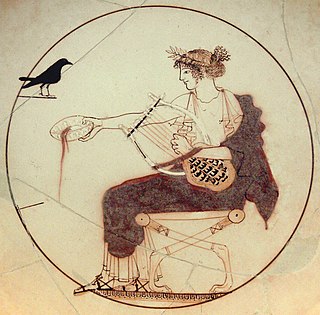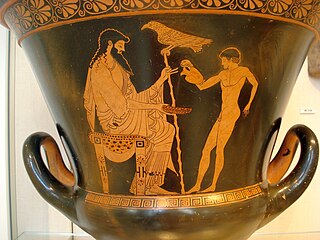
Pottery, due to its relative durability, comprises a large part of the archaeological record of ancient Greece, and since there is so much of it, it has exerted a disproportionately large influence on our understanding of Greek society. The shards of pots discarded or buried in the 1st millennium BC are still the best guide available to understand the customary life and mind of the ancient Greeks. There were several vessels produced locally for everyday and kitchen use, yet finer pottery from regions such as Attica was imported by other civilizations throughout the Mediterranean, such as the Etruscans in Italy. There were a multitude of specific regional varieties, such as the South Italian ancient Greek pottery.

Black-figure pottery painting, also known as the black-figure style or black-figure ceramic, is one of the styles of painting on antique Greek vases. It was especially common between the 7th and 5th centuries BCE, although there are specimens dating as late as the 2nd century BCE. Stylistically it can be distinguished from the preceding orientalizing period and the subsequent red-figure pottery style.

Exekias was an ancient Greek vase painter and potter who was active in Athens between roughly 545 BC and 530 BC. Exekias worked mainly in the black-figure technique, which involved the painting of scenes using a clay slip that fired to black, with details created through incision. Exekias is regarded by art historians as an artistic visionary whose masterful use of incision and psychologically sensitive compositions mark him as one of the greatest of all Attic vase painters. The Andokides painter and the Lysippides Painter are thought to have been students of Exekias.

Red-figure pottery is a style of ancient Greek pottery in which the background of the pottery is painted black while the figures and details are left in the natural red or orange color of the clay.

The Berlin Painter is the conventional name given to an Attic Greek vase-painter who is widely regarded as a rival to the Kleophrades Painter, among the most talented vase painters of the early 5th century BCE.

Nikosthenes was a potter of Greek black- and red-figure pottery in the time window 550–510 BC. He signed as the potter on over 120 black-figure vases, but only nine red-figure. Most of his vases were painted by someone else, called Painter N. Beazley considers the painting "slovenly and dissolute;" that is, not of high quality. In addition, he is thought to have worked with the painters Anakles, Oltos, Lydos and Epiktetos. Six's technique is believed to have been invented in Nikosthenes' workshop, possibly by Nikosthenes himself, around 530 BC. He is considered transitional between black-figure and red-figure pottery.

Psiax was an Attic vase painter of the transitional period between the black-figure and red-figure styles. His works date to circa 525 to 505 BC and comprise about 60 surviving vases, two of which bear his signature. Initially he was allocated the name "Menon Painter" by John Beazley. Only later was it realised that the artist was identical with the painters signing as "Psiax".

The Pioneer Group is a term used by scholars for a number of vase painters working in potters' quarter of Kerameikos in ancient Athens around the beginning of the 5th century BC, around the time of the emergence of red-figure vase painting, which soon displaced the previously dominant black-figure style.

White-ground technique is a style of white ancient Greek pottery and the painting in which figures appear on a white background. It developed in the region of Attica, dated to about 500 BC. It was especially associated with vases made for ritual and funerary use, if only because the painted surface was more fragile than in the other main techniques of black-figure and red-figure vase painting. Nevertheless, a wide range of subjects are depicted.
Geometric art is a phase of Greek art, characterized largely by geometric motifs in vase painting, that flourished towards the end of the Greek Dark Ages, c. 900–700 BC. Its center was in Athens, and from there the style spread among the trading cities of the Aegean. The Greek Dark Ages lasted from c. 1100 to 750 BC and include two periods, the Protogeometric period and the Geometric period, in reference to the characteristic pottery style. The vases had various uses or purposes within Greek society, including, but not limited to, funerary vases and symposium vases.

The Brygos Painter was an ancient Greek Attic red-figure vase painter of the Late Archaic period. Together with Onesimos, Douris and Makron, he is among the most important cup painters of his time. He was active in the first third of the 5th century BCE, especially in the 480s and 470s BCE. He was a prolific artist to whom over two hundred vases have been attributed, but he is perhaps best known for the Brygos Cup, a red-figure kylix in the Louvre which depicts the "iliupersis" or sack of Troy.

Phintias was an ancient Greek vase painter; along with Euphronios and Euthymides, he was one of the most important representatives of the Pioneer Group of Athenian red-figure vase painters. Ten works from the period between 525 BC and 510 BC bearing his signature survive: seven vase paintings and three pottery works. Since his career began before the time of the Pioneer Group, his paintings look somewhat more old-fashioned than those of the other Pioneers; and the influence of earlier red-figure painters such as Psiax or Oltos is strong. Even during the Pioneer Group period he continued to use certain techniques of the black-figure style, e.g. outlines reinforced by scratching and black-figure ornamental borders.

Andokides was an ancient Athenian vase painter, active from approximately 530 to 515 B.C. His work is unsigned and his true name unknown. He was identified as a unique artistic personality through stylistic traits found in common among several paintings. This corpus was then attributed by John D. Beazley to the Andokides Painter, a name derived from the potter Andokides, whose signature appears on several of the vases bearing the painter's work. He is often credited with being the originator of the red-figure vase painting technique. To be sure, he is certainly one of the earliest painters to work in the style. In total, fourteen amphorae and two cups are attributed to his hand. Six of the amphorae are "bilingual", meaning they display both red-figure and black-figure scenes.

Eucharides Painter is the common nickname of an ancient Greek artist who decorated but did not sign Attic vases. Neither his real name, nor the dates of his birth and death are known. Presumably this artist was a pupil of the Nikoxenos Painter.
Robert Manuel Cook was a classical scholar and classical archaeologist from England with expertise in Greek painted vases. He was Laurence Professor of Classical Archaeology at the University of Cambridge, the author of several academic texts and was elected a Fellow of the British Academy in 1974, having been made a Fellow of the German Archaeological Institute in 1953.

The Belly Amphora in the Staatliche Antikensammlungen at Munich is one of the most famous works by the Andokides Painter. The vase measures 53.5 cm high and 22.5 cm in diameter. It dates to between 520 and 510 BC and was discovered at Vulci. It was acquired by Martin von Wagner, an agent of Ludwig I of Bavaria.

Bilingual vase painting is a special form of ancient Greek vase painting. The term, derived from linguistics, is essentially a metaphorical one; it describes vases that are painted both in the black-figure and in the red-figure techniques. It also describes the transitional period when black-figure was being gradually replaced in dominance by red-figure, basically the last quarter of the 6th and the very beginning of the 5th century BC. Their appearance may be due to the initial uncertainty of the market for the new red-figure style, although that style subsequently became dominant rather fast.

The Lysippides Painter was an Attic vase painter in the black-figure style. He was active around 530 to 510 BC. His conventional name comes from a kalos inscription on a vase in the British Museum attributed to him; his real name is not known.

The Amykos Painter was the name given to a South Italian vase painter who worked in the ancient Greek red-figure pottery technique. His exact date of birth and death are unknown.

Ancient Greek art stands out among that of other ancient cultures for its development of naturalistic but idealized depictions of the human body, in which largely nude male figures were generally the focus of innovation. The rate of stylistic development between about 750 and 300 BC was remarkable by ancient standards, and in surviving works is best seen in sculpture. There were important innovations in painting, which have to be essentially reconstructed due to the lack of original survivals of quality, other than the distinct field of painted pottery.
















